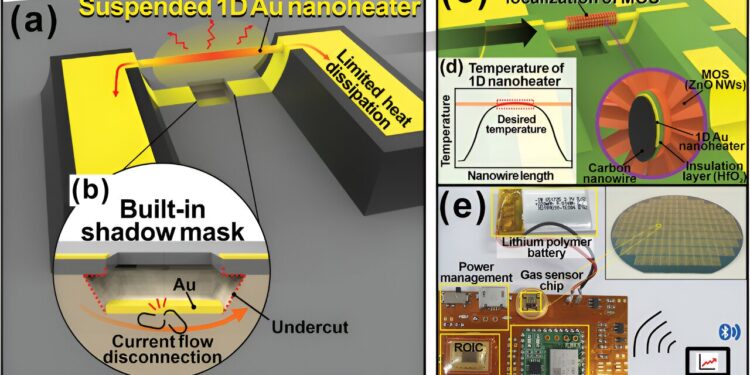Schematic of a suspended 1D nanoheater built on a carbon nanowire framework. Enlarged cross-section of the integrated shadow mask made of SiO2 eaves and sunken structures (red dotted lines) that interrupt the electrical connection (the Au line) along the substrate. Credit: Ulsan National Institute of Science and Technology
A new ultra-small electronic nose (e-nose) operating at ultra-low power consumption opens up application possibilities in various fields, such as air quality monitoring, health diagnostics, food safety and environmental protection.
Professor Heungjoo Shin from the Department of Mechanical Engineering and Professor Jae Joon Kim from the Department of Electrical Engineering at UNIST have successfully implemented an electronic nose that can accurately measure gas type and concentration by integrating nanotechnology and deep learning.
The new electronic nose uses a nano-sized heating semiconductor gas sensor. Unlike conventional sensors that consume a lot of power due to high operating temperatures, this sensor operates with less than 200 microwatts, making it ideal for mobile and IoT devices. In addition, it benefits from high productivity because it exploits semiconductor manufacturing processes.
The high power consumption associated with existing electronic noses has been mitigated through sensor miniaturization, complemented by the introduction of duty cycle technology. This technology reduces power consumption by an additional 90% by periodically cycling power to the heater.
The nano-heater can reach temperatures of 250°C and cool to room temperature in one hundred thousandth of a second, enabling efficient gas measurement even in short duty cycles.
-
Scanning electron microscopy (SEM) images of suspended nano-heater and integrated shadow mask structure. Credit: Ulsan National Institute of Science and Technology
-
Introducing the ultra-low power single-sensor electronic nose system powered by duty cycles and deep learning for real-time gas identification. Credit: Ulsan National Institute of Science and Technology
-
Real-time prediction of gas type and concentration of five gases (air, (a) SO2(b) CO, (c) H2(d) NO2) using dual-response signals (time window = 30 s, duty cycle = 10%, duty frequency = 1 Hz). Credit: Ulsan National Institute of Science and Technology
The research team improved the existing e-nose design, which traditionally required multiple sensors, to work with a single sensor.
Gas desorption from the semiconductor surface occurs more slowly than the operating speed of the nanoheaters. Therefore, during the duty cycle, gas reactions continue even during short periods of heating element cooling. This allows collecting different signals during operation and interruptions of the heating element.
By analyzing these dual signals in real time using a convolutional neural network (CNN), the system can accurately identify different gas types and concentrations.
Professor Shin said, “The limitations of existing electronic noses can be solved with a single sensor,” adding, “This technology can be easily applied to mobile and IoT devices that require miniaturization.”
Professor Kim explained: “The ability to create a low-power micro gas measuring device opens the door to a variety of applications, including real-time wireless monitoring systems.”
The results related to the nanometer-based gas sensor were published in September 2022, and the actual electronic nose technology was published in June 2024 in ACS sensors.
More information:
Taejung Kim et al, Ultra-low power single-sensor electronic nose system powered by duty cycling and deep learning for real-time gas identification, ACS sensors (2024). DOI: 10.1021/acsensors.4c00471
Provided by Ulsan National Institute of Science and Technology
Quote:Scientists combine nanotechnology and deep learning to build ultra-small electronic nose system for real-time gas identification (2024, September 5) retrieved September 5, 2024 from
This document is subject to copyright. Apart from any fair dealing for the purpose of private study or research, no part may be reproduced without written permission. The content is provided for informational purposes only.



